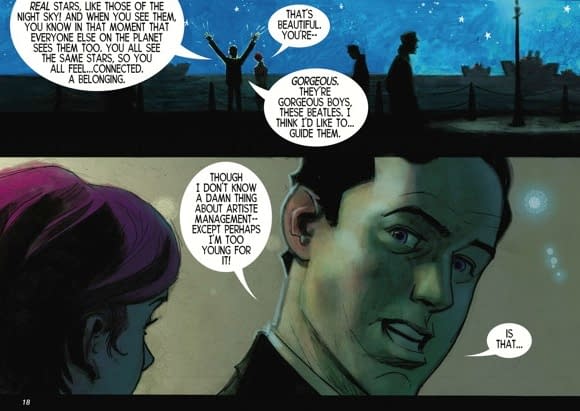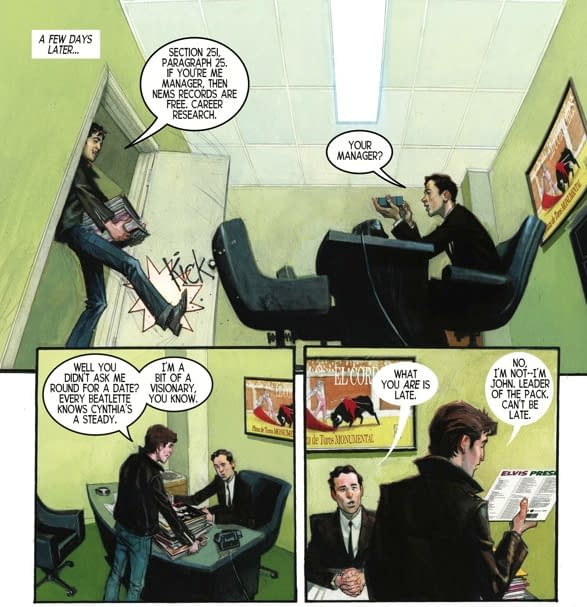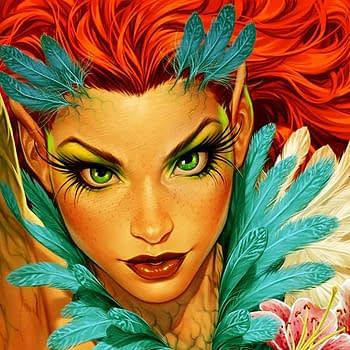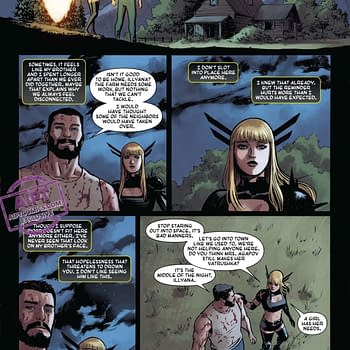Posted in: Comics, Recent Updates | Tagged: Andrew C. Robinson, brian epstein, dark horse, kyle baker, New York Times Best Seller List, Steve Dutro, The Beatles, The Fifth Beatle, Vivek J. Tiwary
The Fifth Beatle Made The NY Times Best Seller List – And It's Easy To See Why

Writer on the book, producer Vivek J. Tiwary, became fascinated by Epstein as a young business student but was, like many pop history enthusiasts, thwarted by a lack of information about Epstein and perplexed by a dearth of common knowledge about a man so influential in the rise of the world's first mega band. Here, he sets out to even that score, along with artists Andrew C. Robinson and Kyle Baker, with Steve Dutro lettering. The interest generated by the book so far justifies Tiwary's early fixation and also the choice of the comics medium to tell a story that's equally biographical, mythological in undertones, and very much about the visual nature of pop culture.
The book is divided into three significant chapters based on era's of Epstein's 6 year career with the Beatles, from discovering them playing The Cavern Club in Liverpool, to Epstein's untimely death at the age of 32. And though the segments of the graphic novel are chronological, the storytelling within each chapter occasionally moves around in time and juxtaposes important, and particularly psychological moments to emphasize symbolic value. The combination of art from Robinson and Baker is one of the most visually nuanced examples you'll see in print right now of a balance struck between painterly aesthetics and more mainstream comics traditions.
Perhaps this was inspired by the fact that photography and references were carefully used to set the stage and narrative of a historically-framed work, but the delicate line-work introduced, particularly when rendering Epstein and other key characters, conveys a depth of feeling about these figures that's almost impossible to ignore. It quickly becomes a very moving book because of the energy, optimism, and tension conveyed in its artwork. The changing color-schemes and layouts are also highly inventive and compelling.
Each chapter of the book differs slightly in color tones as historical eras change, but also within each chapter, performances and social scenes take on a darker, more dream-like aspect whereas business meetings and daylight conversations are often crisp and sharply defined. This often corresponds to a shift in layout also, from more panoramic wide panels in moodier scenes to more focused grids in multi-character conversation scenes. The artists grapple with the overwhelming, boisterous interaction of the Beatles as a group by taking a different approach every time these moments are conveyed—first through broken up grids, then through serpentine use of speech bubbles, and even breaking at last into lighthearted cacophony. The art on the book seems to find its way through various challenges, making the eclectic work for the narrative in fresh ways.

Tiwary's writing on the book initially conveys Epstein to be a sympathetic but somewhat puzzling character. He seems larger than life in his self-confidence and buoyancy and in his strange, monomaniacal certainty that this backup band who no one has ever heard of will one day take over the world. That might inspire skepticism in readers since it's easy, in hindsight, to attribute a degree of prescience to individuals so closely involved in building legends. This proves to be, however, an aspect of Epstein's character that becomes more believable as the story progresses and readers witness the impact such an intense focus can have on a person, their health, and their private life. If Epstein seems larger than life, we begin to suspect that his obsessions have a lot to do with that, and even are given pause to consider the ways in which firmly stated beliefs can influence others. Details included in the way that Epstein speaks, the patterns of interaction with his family, and his assistant Moxie, gradually create a fully developed character for readers that breaks through hype and establishes a different kind of universal mythology—that of a man and a somewhat dangerous dream.
Also of note is the significant role of gay themes in the book, present from the earliest chapter, and the psychological angle that Tiwary adds to Epstein's lonely personal life at the hands of British law forbidding homosexuality and medical professionals attempting to "treat" it during the 1960's. It's more than background noise in the book, and is handled with a degree of honesty that helps establish some of the inner workings of Epstein's life and the often-overwhelming pressures that he faced. The overall character arc that Tiwary develops seems to move from savior-like visionary, to embattled crusader, to self-sacrificial hero. And somehow, in all that, Tiwary makes sure that Epstein continues to feel fully human rather than an icon for reverence. One of the ways he accomplishes this is through keeping the forays into Epstein's psychology fairly brief and balanced, returning to an observer's position and allowing the reader to draw their own conclusions. It's a light enough touch that it keeps the book historical rather than hagiographical.
Comics are increasingly addressing historical settings and biographical material, and the manner in which they can be directed to convey mood and atmosphere, and to influence interpretation is fairly vast. The Fifth Beatle does quite a service to music history by engaging directly with the strengths of the comics medium in the hands of accomplished artists who bring personal ingenuity and tone to the work and also by taking on an ambitious writing schema that packs in dozens of episodes, moments, and conversations, while making an intelligible whole that creates an impression of Epstein and also of an era.
When I had a look at the collector's edition of the book, I was even more aesthetically impressed by the wealth of sketches, process work, and commentary it contained to help set the stage for just how a graphic novel like this came about. The simple answer is lots and lots of determination and hard work, but the more complex truth is that each of the members of the team clearly brought their own obsessions to the table in order to create this story of vision, obsession, and the often tragically high price of success.
Hannah Means-Shannon is Senior New York Correspondent at Bleeding Cool, writes and blogs about comics for TRIP CITY and Sequart.org, and is currently working on books about Neil Gaiman and Alan Moore for Sequart. She is @hannahmenzies on Twitter and hannahmenziesblog on WordPress. Find her bio here.


















